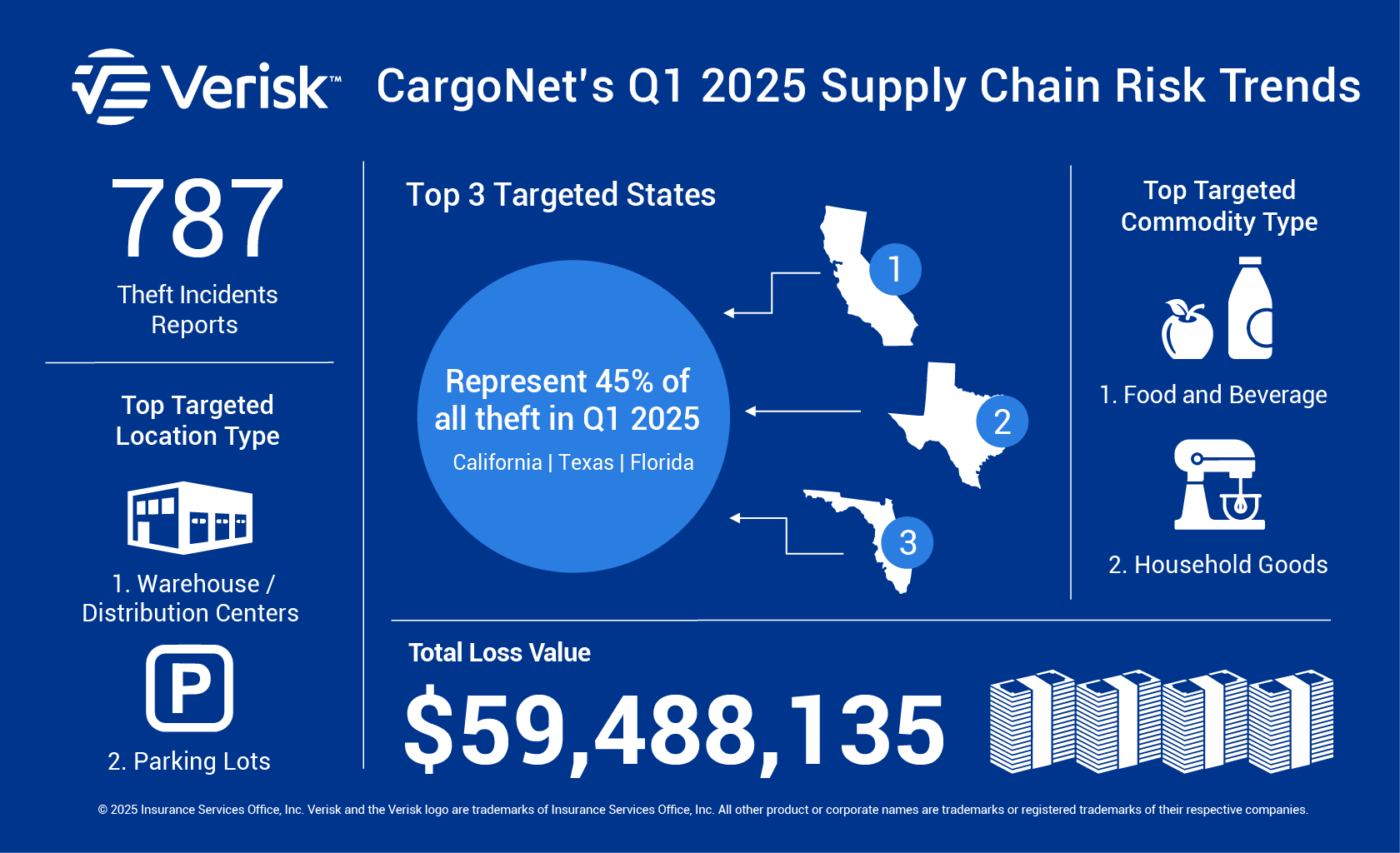CargoNet Reports 8% Decline in Cargo Theft for First Quarter 2025, With Shift Toward Staple Goods and Metals
JERSEY CITY, NJ — CargoNet, a Verisk Analytics company and leader in cargo theft prevention and recovery, today released its first quarter 2025 cargo theft analysis, revealing a continued downward trend in overall incidents but a shift in targeting patterns towards theft of essential goods and valuable raw materials.
Key Findings:
- A total of 787 cargo theft incidents were recorded across the United States and Canada in Q1 2025, representing a 7% decrease year-over-year and an 8% decrease from Q4 2024. Despite fewer incidents, stolen goods were valued at $63.34 million for the quarter, with the average theft valued at $237,095.
- Direct theft incidents increased by 100 events (29%) compared to Q1 2024, while identity fraud reports decreased by 126 (44%).
- Food and beverage commodities saw substantial increases in theft activity, particularly meat products (242% increase) and beverages (65% increase for alcoholic, 94% increase for non-alcoholic).
- Metal thefts rose significantly, with copper theft up 85% amid record-high market prices.
- California continues to lead in theft incidents but shows a 21% year-over-year reduction.
"The first quarter data aligns with our earlier projections that cargo theft activity would likely decrease in 2025, but the shift in targeting patterns reveals how adaptable cargo thieves remain," said Keith Lewis, VP of Operations at CargoNet. "We're seeing a clear pivot toward essential consumer goods and raw materials with strong market demand, particularly food products and metals like copper."

Evolving Fraud Tactics
The significant decrease in identity fraud reports (44% year-over-year) doesn't necessarily indicate a reduction in criminal activity but rather a shift in methodology. CargoNet analysis suggests many fraudulent activities now incorporate business email compromise (BEC) techniques, where thieves gain unauthorized access to legitimate business email accounts to impersonate companies and intercept shipment tenders. Compromise of an official email account is much harder for companies to detect than use of an email account that has not been historically affiliated with the carrier, leading to a higher success rate for criminals looking to steal shipments.
"The line between theft and fraud continues to blur as criminals develop more sophisticated approaches," noted Lewis. "We first identified this trend in Q3 2024, and it has now become a predominant strategy."
Geographic and Temporal Patterns
California remains the state most affected by cargo theft with a total of 249 incidents, though this represents a 21% decrease from the 317 incidents reported in Q1 2024. Texas maintained its position as the second most targeted state with 89 incidents.
Analysis of theft by day of week reveals a distinct "V" pattern - high activity early in the week, a midweek dip, followed by a sharp spike on Fridays, which now account for 21% of all incidents. Friday thefts offer criminals a significant advantage: stolen trailers often go unnoticed until Monday morning, providing a weekend-long head start. Additionally, logistics firms rushing to arrange shipments before the weekend are more vulnerable to theft by deception schemes as they scramble to find carriers before the close of business.
Equipment Theft Trends
The first quarter saw substantial increases across equipment theft categories:
- Semi-tractors: 135 units stolen (up 38% from 112 in Q1 2024)
- Semi-trailers: 204 units stolen (up 39% from 146 in Q1 2024)
"The evolving nature of cargo theft requires a similarly adaptive security approach," concluded Lewis. "While we're encouraged by the overall decrease in incidents, the increase in direct theft activity and the shift toward essential goods highlights the need for continued vigilance throughout the supply chain."
Mary Keller
339.832.7048
mary.keller@verisk.com
